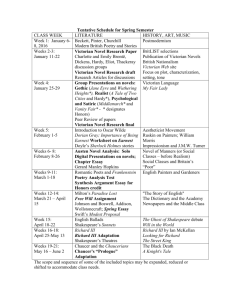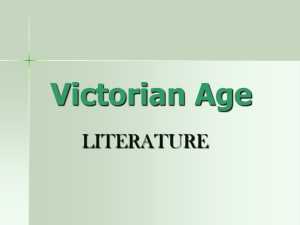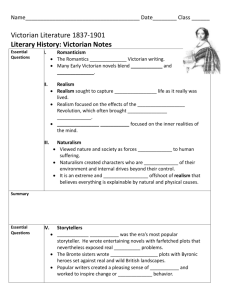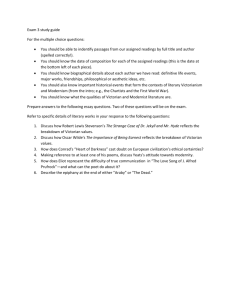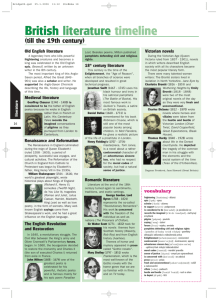Victorian Period Presentation for Enrichment
advertisement
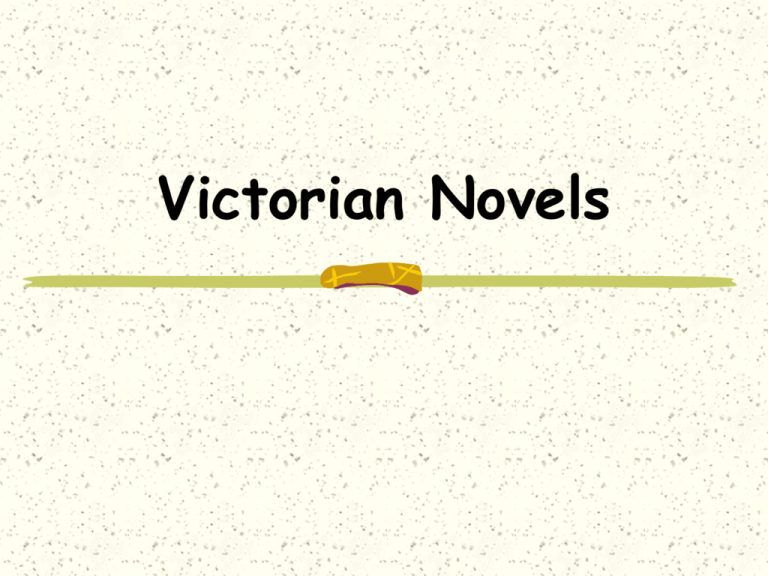
Victorian Novels Social Background England was the “workshop of the world.” Widespread poverty and wretchedness among the working class. People were trying to live up to a national spirit of earnestness, respectability, modesty and domesticity. Common sense and moral propriety, which were ignored by the Romanticists, again became the predominant preoccupation in literary works. Victorian Literature Literature produced during this period reflects the “spirit of the times”: Expansion of newspapers and periodicals led to ongoing debates about current political and social issues. Victorian literature (especially novels) offered a realistic, day-to-day portrayal of social life and represented these issues in the stories of the characters. Suddenly, the once-silent female segment of society raised their voices. They could even appear onstage, acting in dramas (a privilege denied to them prior to this time). Victorian Literature Chronologically the Victorian period roughly coincides with the reign of Queen Victoria over England from 1836 to 1901. In literature, the early Victorian age can be said to be the age of critical realism. The critical realism of the 19th century flourished in the forties and in the early fifties. Puritan morality of the early and mid Victorian period was reflected in the novels. In Victorian novels the society’s effects on individual are analyzed. The Victorian Poetry Victorian poetry developed in the context of the novel. Poets sought new ways of telling stories in verse. All poets show the strong influence of the Romantics, but cannot sustain the confidence the Romantics felt in the power of the imagination. Victorian poets often rewrite Romantic poems with a sense of belatedness. Dramatic monologue – the idea of creating a lyric poem in the voice of a speaker ironically distinct from the poet is the great achievement of Victorian poetry. The Victorian Drama The theater was a flourishing and popular institution during the Victorian period. The popularity of theater influenced other genres. Bernard Shaw and Oscar Wilde transformed British theater with their comic masterpieces. Victorian Literature The novel became the dominant form of literature Novels were commonly read aloud in family gatherings. This led to novelists avoiding some topics which would be inappropriate for the entire family. Readers wanted to be guided and enlightened by authors. Much of Victorian literature has a positive, eager or earnest response to the innovations of life in the 19th century The Victorian Novel Victorian novels seek to represent a large and comprehensive social world, with a variety of classes. Victorian novels are realistic, their major theme is the place of the individual in society, the aspiration of the hero or heroine for love or social position. The protagonist’s search for fulfillment is emblematic of the human condition. For the first time, women were major writers: the Brontës, Elizabeth Gaskell, George Eliot. The Victorian novel was a principal form of entertainment. Victorian Novels Most were concerned with people in society and with manners, morals and money. Typically a protagonist struggles to find him or herself in relation with other men and women, in love or marriage, with family or neighbors, or with work associates. Most novels were set in 19th century England, a world that would be recognizable to the reader. Many novels were published in installments. This challenged the writer to sustain the interest of the readers. In every single installment they had to entertain. Aspects of Victorian Novels Realism – capturing everyday life as it really is lived; identified social problems: Charles Dickens, William M. Thackeray, Charlotte Brontë, & Emily Brontë. Psychological realism – focused on inner realities of the mind: George Eliot’s. Naturalism – views nature and society as forces indifferent to human suffering. E.g. Thomas Hardy. Novel of Realism Renders reality closely and in comprehensive detail. Characters appear in their real complexity of temperament and motive; They are in explicable relation to nature, to each other, to their social class, to their own past. Character is more important than action and plot; Complex ethical choices are often the subject. Events will usually be plausible. Realistic novels avoid the sensational, dramatic elements of naturalistic novels and romances. Novel of Realism II Class is important; The novel has traditionally served the interests and aspirations of an insurgent middle class. Selective presentation of reality with an emphasis on verisimilitude, even at the expense of a wellmade plot. Diction is natural vernacular, not heightened or poetic; Tone may be comic, satiric, or matter-of-fact. Objectivity in presentation becomes increasingly important: overt authorial comments or intrusions diminish as the century progresses. Critical Realism The critical realists described with much vividness and artistic skill the chief trait of the English society, and they criticized the capitalist system from a democratic viewpoint and delineated the crying contradictions of the social reality of that time. The English critical realists of the 19th century not only gave a satirical portrayal of the bourgeoisie and all the ruling classes, but also showed profound sympathy for the common people. Charles Dickens (1812-1870) Without doubt the most popular of Victorian writers was Charles Dickens. His combination of sentimentality and his attacks on the social evils of the day made him highly successful. He is concerned with the problems of crime and poverty and the life of the lower class. William Makepeace Thackeray (1811-1863) English journalist, novelist, famous for his novel Vanity Fair. William Thackeray wrote of the upper classes. "This I set as a positive truth. A woman with fair opportunities, and without a positive hump, may marry whom she likes." The Brontë sisters Charlotte (1816-1855): Jane Eyre Emily (1818-1848): Wuthering Heights Anne: Agnes Grey The Sisters & their Identities Wutheirng Heights and Agnes Grey were accepted for publication before Charlotte had finished writing Jane Eyre. However, their publisher delayed bringing their novels out so that Jane Eyre was published first. It became a best seller. In an effort to cash in on the success of Jane Eyre, he implied that Wuthering Heights and Agnes Grey were written by "the author of Jane Eyre–to the distress of all three sisters. The pseudonyms they had adopted unintentionally contributed to his deception. The Sisters & their Identities Wanting their works to be judged for their literary merit and not on their sex, Anne, Charlotte, and Emily published their novels under names which were not obviously masculine, Acton, Currer, and Ellis Bell. Preserving their male identities was so important to the Brontë sisters that Charlotte maintained that identity even in writing to her publishers. In order to prove to Charlotte's publishers that Acton, Currer, and Ellis Bell were not one person, Charlotte and Anne met with them in London; during the interview, Charlotte inadvertently revealed that they were three sisters. Charlotte Brontë Charlotte wrote three other books, Shirley, Villette,and The Professor.In 1854 Charlotte married.But she died in the following year after a lengthily painful illness. Charlotte Bronte published Jane Eyre under the pen name Currer Bell, in London in 1847. Bildungsroman A novel of formation or a coming-of-age story --- the story of a child’s maturation and focuses on the emotions and experiences that accompany and incite his or her growth to adulthood. Such a novel takes the reader through a character's young adulthood as she defines her identity against forces of opposition. Emily Bronte (1818 - 1848) On July 30, 1818, Emily Bronte was born in Thornton, Yorkshire. Most accounts portray Emily as the brightest, most intense, and most difficult of the three sisters. Her "powerful and peculiar" character, said Charlotte, inspired "an anguish of wonder and love." George Eliot (1819-1880) The pseudonym of Mary Ann Evans, born in Warwickshire, England in 1819 Called “the embodiment of philosophy in fiction” by Oscar Wilde Adam Bede (1859) The Mill on the Floss (1860) Silas Marner (1861) Middlemarch () Daniel Deronda (1876). Naturalism Characters’ lives are governed by scientific determinism, i.e., heredity and environment. To show this determinism, naturalists often create weak and passive characters. The naturalistic trap. Sex and violence are bed partners; sex is brutish, without tenderness. Violence dominates the lives of the naturalistic character. The beast in man. The chronicle of decline. Zola showed writers how to document the determinism. Thomas Hardy The last and one of the greatest of Victorian novelists His best local-colored works: 1. 2. 3. 4. The Return of the Native The Mayor of Casterbridge Tess of the D’Urbervilles Jude the Obscure (1840-1928) Characteristics of Hardy’s Writing 1) 2) 3) Hardy is a meditative story-teller or romancer, as well as a great painter of nature. Naturalism has played an important part in Hardy’s works. His heroes and heroines are all vividly and realistically depicted. Hardy's characters have a fascinating ambiguity: they are victimized by a stern moral code, but they are also selfish and weak-willed creatures who bring on much of their own difficulties through their own vacillations and submissions to impulse. All works of Hardy are noted for the rustic dialect and a poetic flavor which fits well into their perfectly designed architectural structures. Novels of character & environment His pessimistic philosophy seems to show that mankind is subjected to the rule of some hostile and mysterious fate, which brings misfortune to human life. The outside nature is shown as mysterious supernatural force, uncaring to the individual’s will, hopes, passion, or suffering. It likes to play practical jokes upon human beings by producing a series of mistimed actions and unfortunate coincidences. Man proves impotent before Fate, however he tries, and he seldom escapes his ordained destiny. Literary Criticism Tess of the d’Urvervilles Editors forced Hardy to rewrite parts of it Well received, but heavily criticized Jude the Obscure Harsh criticism- considered blasphemous Critic G.K. Chesterton wrote that Hardy “became a sort of village atheist brooding and blaspheming over the village idiot” Because of the criticism, Hardy was “cured” of his desire to write novels, and returned to poetry Tess of the D’Urbervilles: A Pure Woman It came into conflict with Victorian morality. It explored the dark side of his family connections in Berkshire. The tragic story of a woman wronged by two men and by the harsh, repressive society in which she lives. Hardy's most striking and tragic heroine, Tess is a woman of intense vitality and innate goodness, and the author's favorite character. Tess Tess, a poor peasant girl, is seduced by Alec. Then she meets Angel Clare who falls in love with marries her. On their wedding night They tell each other about their past, hoping to be forgiven by each other. But after hearing Tess’s confession, Clare leaves her abruptly for Brazil. Poverty forces Tess to seek for work at a farm where she is insulted by the master. Her father’s death and the poverty of her family drive her to seek for assistance from Alec. Tess of the D’Urbervilles: A Pure Woman Alec soon resumes his former illicit relations with her. Tess can do nothing but obey. Angel Clare returns repentant and ready to be reconciled to Tess, but Tess finds that her living with Alec hinders her from returning to Clare. She kills Alec in hatred and despair and then is quickly arrested, tried and hanged. The Transformation of the English Novel: 1890-1930 The novels of Hardy, Lawrence, Conrad, Joyce, Forster and Woolf represent a radical break from the past. The great change in major British fiction from the realistic to the expressionist novel begins roughly in 1895, the year of Hardy’s last novel, Jude the Obscure, and reaches a climax with Woolf’s major novels, Mrs. Dalloway (1925) and To the Lighthouse (1927). Influenced by English romanticism, developments in modern art, and a changing intellectual milieu that questioned the possibilities of universal values or objective truth, these novelists erased the boundaries between art and life. They no longer believed that they could or should recreate the real world in their art and they questioned the assumption that verisimilitude was the most important aesthetic value. They realized that each man perceived a different reality. According to traditional writing techniques developed before the 20th century, a piece of narrative works should tell a vivid, interesting story and portray one or more characters who have distinct traits and who are often involved in certain kind of psychological or social conflicts which, with the development of the plots, will in the end come to certain solution. This kind of notion, however, was fiercely attacked since the end of 19th century. Since then the concept of narrative literature and its writing techniques have undergone profound changes. Stylistic Innovations of Modernist Novels Reality as understood by traditional writers was merely the mortal beings and natural objects in the material world. Thus the task of the traditional writers was to reflect and imitate this exterior world. Modern short story writers, however, turn to explore and delve into man’s interior world. Instead of looking at the stern reality from the angles of money, class status, social desire, or other material desires, they tend to be preoccupied by the sub-consciousness of the mind; they pay more attention to human beings’ experience, feeling, and introspection.
